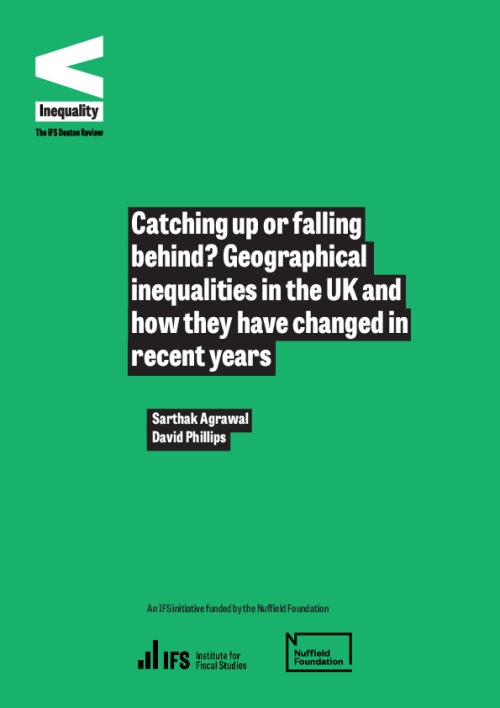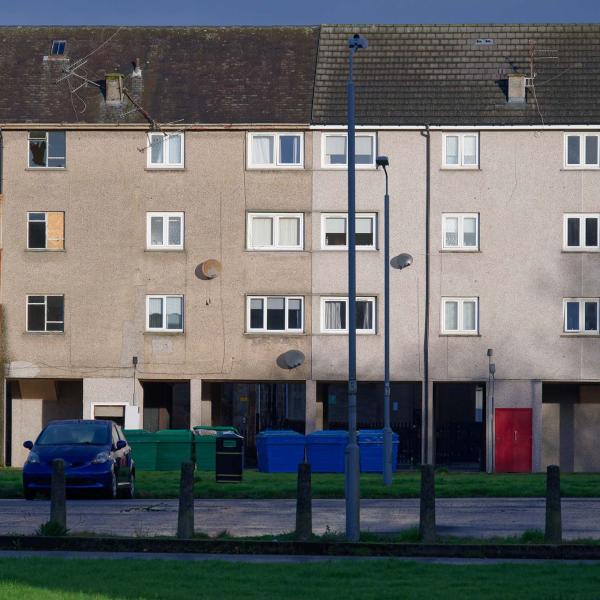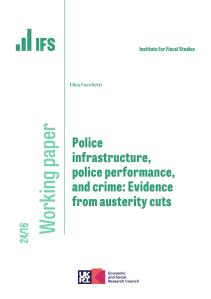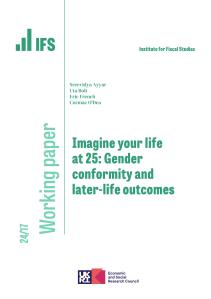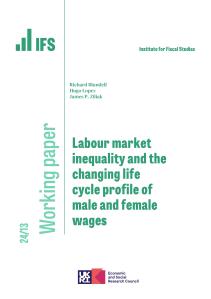The COVID-19 crisis has brought to the fore increasing concerns about inequalities not only between different population groups – such as the gap between the rich and poor, young and old, and different ethnic groups – but also between people living in different places. Even prior to the crisis though, there was a sense that the UK is not only a highly geographically unequal country, but also an increasingly geographically unequal one.
Such concerns are of significant political import. The Johnson government has made ‘levelling up’ the economy, living standards and life chances across the country a mantra, and has announced a review of guidance for infrastructure investment aimed at increasing the proportion going to the Midlands and North of England.
But just how geographically unequal is the UK? Is it true that these inequalities have been getting worse? Are there particular regions or types of places that have been doing particularly well or poorly? And what risks of widening and opportunities for narrowing these gaps might the COVID-19 crisis bring?
Focusing on productivity, earnings and household incomes, this report finds that:
Geographical inequality in incomes is much lower after accounting for variation in housing costs
- Productivity and earnings in London are a third to a half higher than the UK average – although part of the benefit of this goes to commuters working in London but living in the East and South East of England. Wales has the lowest productivity and earnings, approximately 15% below the UK average and around 40% below London.
- The picture for household incomes depends on whether they are measured before housing costs (BHC) or after housing costs (AHC). Measured BHC, median household income in London is around 14% higher than the UK average, but measured AHC it is only 1% higher. Measured AHC, median household income varies between 9% above the UK average in the South East of England to 7% below it in the North East of England.
- Inequality is far higher within London than in any other part of the UK, with London over-represented at both the bottom and the top of the income distribution nationally. Measured AHC, 28% of Londoners live in poverty, compared with 22% across the UK as a whole; and yet 16% of Londoners are in the top 10% of the national income distribution.
- AHC poverty rates in most lower-income regions are only a little higher than the UK average – 23% in Wales and 24% in the North East, for example – and are actually below the UK average in Northern Ireland, at 19%. But households with high incomes are significantly under-represented: 6% or less make it into the top 10% of the income distribution in all three of these regions. In other words, it is having few households with very high income levels, rather than lots of households with very low incomes, that characterises the ‘poorer’ regions of the UK.
Regional inequality is not increasing for incomes, but it is for wealth
- Median household income BHC in London has grown at roughly the same rate since 2002 as in the rest of the UK: 11% compared with 12%. And it has actually grown faster in the period since 2007, despite larger falls in average earnings among working Londoners since then: median full-time earnings for workers in London are down 5.0% versus 2.6% in the rest of the country. This reflects particularly strong growth in employment in the capital: up 5.3 percentage points in London compared with 2.7 percentage points in the rest of the UK post 2007. However, increasing housing costs mean that median household AHC income has grown by just 6% in London since the early 2000s, compared with 13% in the rest of the UK (and this pattern is evident both before and after the late 2000s recession). More generally, regional differences in median AHC incomes across the UK have narrowed since 2002.
- This reflects two trends: the fact that more households rent their home in London than in the rest of the country; and particularly large increases in property prices and rents in London (and surrounding areas). A large share of renters means that middle-income Londoners have not benefited as much from falls in mortgage interest rates as in the rest of the country. Rapid increases in property prices mean Londoners who do take out a mortgage have to take out increasingly bigger ones compared with the rest of the country. And faster increases in rents mean the share of income that rent accounts for has increased relative to the rest of the country.
- On the other hand, the increasing divergence in property values around the country has contributed to an increase in wealth inequality between regions. Mean property and financial wealth (excluding the value of accrued private pensions) increased by 150% in London in the ten years to 2016–18, compared with 50% across Great Britain as a whole and less than 20% in most of the Midlands and North of England, according to the Wealth and Assets Survey. Median property wealth is estimated to have increased by almost 180% in London and almost 50% in the South East over the same period, but to have fallen in most of the Midlands and the North.
Local inequalities are significant, especially within London & the South
- Inequalities between local authorities (LAs) within regions are even larger than inequalities between regions, and this is especially true in the South of England. For example, median full-time earnings are 53% above the UK average in Kensington & Chelsea in West London and 3% below it in Barking & Dagenham in East London. Within the East and South East of England, they are much higher in well-to-do commuter areas such as Brentwood and South Bucks than in areas further from London such as North Norfolk and Hastings. Median full-time earnings in the latter are 16% and 19% below the UK median, respectively, despite being in ‘high-wage’ regions.
- Variation between LAs is lower in the North and Midlands, but still not insignificant. As in the South, the areas with the highest earnings tend to be commuter areas for major cities including Trafford, which neighbours Manchester, and Solihull, next to Birmingham. Median full-time earnings in these LAs are 11% and 14% above the UK median, for example.
- LA-level inequality in mean and median earnings has fallen somewhat since the late 2000s recession. This likely reflects falls in earnings at the top of the earnings distribution dragging down earnings in LAs with relatively high earnings levels, and increases in minimum wage levels (including via the introduction of the National Living Wage) pushing up earnings more in LAs with relatively low earnings levels.
Former industrial towns in the North and Midlands and coastal towns have not been falling further behind – but are poorer
- Despite concerns about the performance of towns and the countryside relative to cities, mean full-time earnings and household incomes are higher and, if anything, have grown faster outside cities than inside them since the early 2000s, especially in the North and Midlands.
- LAs covering former industrial towns in the North and Midlands have lower earnings than LAs covering other parts of these regions, and LAs covering coastal towns have lower earnings than other LAs. The latter gap is lower than in the early 2000s, but these types of places have not made up for the declines in their fortunes seen in the last quarter of the 20th
What explains growing concerns about geographical inequalities?
Thus, while for earnings and incomes there are big differences between different regions and especially LAs, these differences have been falling somewhat since the early 2000s. This begs the question: why have concerns about geographical inequality come to the fore in the last few years? There are many possible reasons, but several stand out.
First is that recent small falls in geographical inequality in earnings have done little to undo the bigger increases that took place in the last quarter of the 20th century: many places are still living with the legacy of deindustrialisation. Second is that, more generally, earnings and incomes have stagnated since the late 2000s recession, and this may have made geographical inequalities more salient. Third is that headline figures on productivity, earnings and household incomes may be missing underlying trends and other important aspects of inequality that people care about. The flip side of the increases in housing costs in London and surrounding regions, pulling down AHC incomes, is an increase in property values and wealth. And there is evidence that inequalities in health, education and social mobility have grown. These are issues that we will explore more as the IFS Deaton Review progresses.
It is also clear that different regions and locales face different issues, and one-size-fits-all policies for tackling geographical inequalities would be inappropriate. In London and surrounding areas, the big challenge is high housing costs, which take up a large fraction of income, especially for poorer households. Elsewhere, low productivity and a paucity of high-paying jobs seem more of a concern. Understanding the factors driving these issues and how they could be tackled is therefore vital.
The COVID-19 crisis poses risks but also opportunities
It will also be important to monitor the evolving impact of the COVID-19 crisis on geographical inequalities. Differences in economic structures and reliance on different modes of transport mean differing degrees of exposure to the economic effects of the acute phase of the crisis. In particular, both rural and coastal areas – often reliant on the hospitality industry – and the centres of major cities – often reliant on public transport – look exposed to particular economic risks. How these risks will crystallise and persist, though, is as yet unclear, and there could be opportunities as well as challenges. In particular, an increase in remote working could reduce the pull of London for the highest-productivity and highest-paid jobs and workers, and increase access to economic opportunities in more peripheral areas.
Thus, as the government seeks to turn ‘levelling up’ from a soundbite into actionable policy, it will have to carefully consider how to respond to the evolving impacts of COVID-19, as well as pay heed to the pre-existing differences in the challenges facing different parts of the country.
